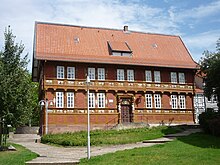Alfeld
History
The town was founded before 1214, with the name Alvelde recorded in 1214, 1221, and 1233. The toponymic element "-feld" means "open area", "an undeveloped, open field", or "an untilled field". "Al-" likely derives from the Indoeuropean root "el-/ol-" meaning "water", "damp", or "flowing".
In 1426, Alfeld joined the Saxon League of Towns, thus becoming an indirect member of the Hanseatic League. The town was one of the smallest cities in the Hanseatic League, but had become prosperous in the fourteenth and fifteenth century through its trade in beer, hops, linen, and yarn.
Alfeld originally belonged to the Diocese of Hildesheim, but was transferred to the Principality of Brunswick-Wolfenbüttel after the Hildesheim Diocesan Feud (1519-1523). In retrospect, this Brunswick period constituted Alfeld's Golden Age, its economy and culture flourishing before the Thirty Years' War.
Main Sights
Sights in Alfeld include the town hall (1586) with its octagonal tower, the church Saint Nicolai and the Fillerturm, a medieval watchtower, and the Fagus Factory of 1911, a fine example of early modernist architecture by Walter Gropius. More famous are the Seven Hills (German: Sieben Berge) in the north and the Lippoldshöhle ("Lippold's cave"), where a legendary robber-knight is said to have lived.
Culture
The assertion that the popular fairy tale of Snow White and the Seven Dwarfs was born in Alfeld is false. Even though the miners who mined ore In the Seven Mountains believed in the existence of dwarfs, it is more likely that the cradle of the fairy tale is to be searched in France. The version the brothers Grimm heard and wrote down, as they travelled through the Seven Mountains, on the so-called Märchenstrasse (Street Of Fairytales) is just one of many.
The most popular beer in Alfeld is Einbecker Brauherrn, from Einbeck, about 12 kilometers or so, away, south of Alfeld. Veltins Pilsner, Flensberger Pils and Gottinger Pils are also popular beers in Alfeld.
Economy

The biggest employer of the city is the SAPPI (South African Pulp and Paper Industry) factory with its big chimney, which has become one of Alfeld's landmarks. Even more famous than SAPPI is the Fagus Werk, rebuilt in 1910-1915 after the blueprints of architect Walter-Gropius, what is said to be trend-setting for modern architecture.
Popular culture

Alfeld is a strategically important town fought over repeatedly by NATO and the Soviet Red Army forces in Tom Clancy's novel Red Storm Rising, due to the bridges over the Leine River.
International relations
Alfeld is twinned with:
 Wakefield, United Kingdom
Wakefield, United Kingdom
Notable people
- Augustine of Alfeld (1480–1535), Franciscan and controversial theologian
- Walter Kappe (1905–1944), German Nazi, who, as an emigrant in the US in the 1930s, created propaganda and committed espionage in service of Nazism
- Uwe Schmidt (born 1954), German politician (SPD) and since July 2009, head of the district Kassel
- Albrecht von Goertz (1914–2006), German industrial designer
- Zbigniew Żedzicki (born 1945), Polish wrestler
See also
References
- ^ "Stichwahlen zu Direktwahlen in Niedersachsen vom 26. September 2021" (PDF). Landesamt für Statistik Niedersachsen. 13 October 2021.
- ^ "LSN-Online Regionaldatenbank, Tabelle A100001G: Fortschreibung des Bevölkerungsstandes, Stand 31. Dezember 2022" (in German). Landesamt für Statistik Niedersachsen.
- ^ "Wakefield's twin towns". Wakefield City Council. Archived from the original on 2013-10-17. Retrieved 2013-07-14.
External links
- Official website
 (in German)
(in German)
